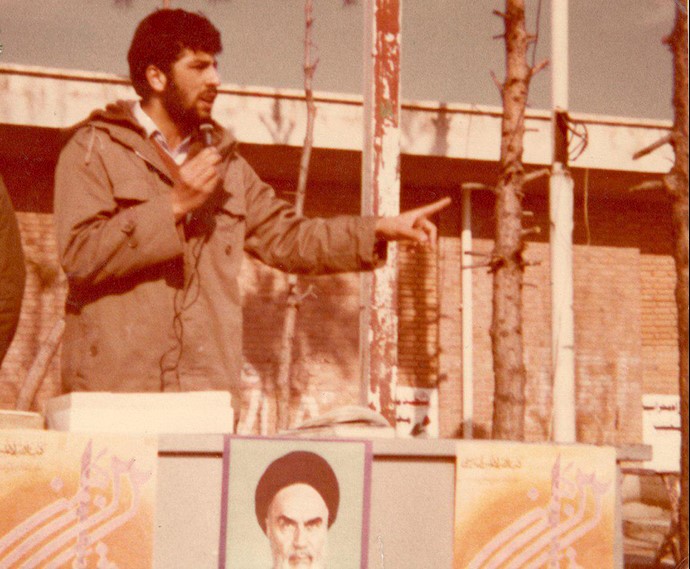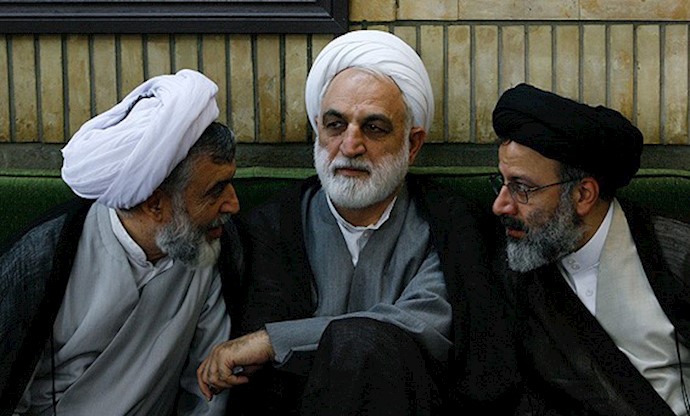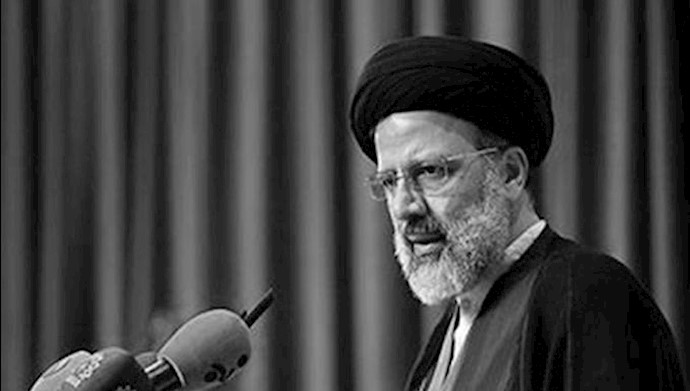Iran, March 20, 2019
Severing hands has been our greatest pride
(Ebrahim Raisi – October 26, 2010)
On March 7, 2019, after weeks of delay, Ali Khamenei, the supreme leader of Iranian regime, appointed Ebrahim Raisi as the head of the judiciary. Raisi is a cleric known as a criminal for participating in the largest massacre and genocide after World War II, the massacre of 30,000 political prisoners in 1988.
Before joining the judiciary, he was the Special Attorney General for clerics, caretaker of the Astan-e-Quds-e-Razavi charity foundation and a member of the Assembly of Experts. During the presidential election of 2017, Raisi was nominated as Khamenei’s favored candidate. But as a result of persistent revelations by the Iranian Resistance and PMOI/MEK about his role as a perpetrator of the killing and massacre of 30,000 political prisoners, he faced serious obstacles in his goal to climb to power.
Who is Ebrahim Raisi?

Ebrahim Raisi, in the early years of 1979 revolution
Ebrahim Raisosadati, known as Ebrahim Raisi, was born in Mashhad’s district of Noghan in 1960. After completing elementary school, he went to the Cleric Institute of Mashhad. His school education is only up to the sixth grade. At the age of 15, Raisi left Mashhad to study in Qom’s seminary.
After the 1979 Revolution, Raisi, then 18, attended Qom’s Haqqani School to study the senior management of the judiciary, intelligence and security services of the clerical regime with other clerics such as Ali Fallahian, Roohollah Hosseinian, Mostafa Pourmohammadi, and others.
After the revolution, Ebrahim Raisi became one of the elements of the main core of power, the machine of repression in the newly established religious dictatorship in Iran.
In the first days of the establishment of the mullahs’ regime, Hadi Marwi, a representative of regime founder Ruhollah Khomeini in the city of Masjed Soleyman, invited Raisi to join the prosecutor’s office of mullahs’ regime, where his duty was suppressing dissidents and opposition groups.
After all the repressions in Masjed Soleyman, Raisi, while he wasn’t any more than 19 years old, was sent to the prosecutor’s office of Karaj, where his work was essentially interrogating the opponents of the Iranian regime. After a few months, Ali Ghodosi, then Attorney General, appointed Raisi as the prosecutor of Karaj after his 20th birthday. In 1983, after months of committing atrocities and crimes in Karaj, he was also appointed as a prosecutor of Hamadan. As the cities were 340 Kilometers apart, he spent half a week in Karaj and the other half in Hamedan, until he was completely relocated to Hamedan after four months.
Raisi continued the crackdown on the opposition groups as the prosecutor in Hamedan until 1985.
After that, the 24-year old cleric was promoted to the General Prosecutor’s Office as the “associate deputy.” The Attorney General had three deputies back then: The Economic Deputy, the Deputy Director of Drug Trafficking and the so-called “Associate deputy,” whose duty was to crack down on opposition groups, including the PMOI/MEK. During the summer 1988 massacres, as a Deputy Prosecutor General, Raisi was member of “Death Committee” that put thousands of political prisoners to death.
Death Committee

Ebrahim Raisi (right) along with judiciary spokesperson Gholam-Hossein Mohseni-Eje’i (center) and Hossein Ali Nayeri, another member of the 1988 Death Commission
In the summer of 1988, on Khomeini’s orders, more than 30,000 political prisoners were executed in Evin prisons in Tehran, Gohardasht, Karaj, and other prisons across Iran. Ebrahim Raisi, then successor of the Attorney General of Tehran, along with Hossein Ali Nayeri (The judge of Shari’a), Morteza Eshraqi (Prosecutor of Tehran), Mostafa Pourmohammadi (Ministry of Information deputy), and Ismail Shooshtari (head of the department of Prisons) were the central decision makers of these executions, known as the Delegation of Death. The delegation was commissioned by Khomeini to clarify the situation of those political prisoners who did not changed their opinions against the clerical dictatorship and in support of PMOI/MEK.
The speed and volume of executions were so terrible that this crime against humanity and genocide created divisions and disputes within Khomeini’s own officials. The most notable case was Hossein Ali Montazeri, who was Khomeini’s successor at that time. Montazeri objected to Khomeini’s approach to dealing with the PMOI/MEK. Montazeri believed that the solution to the PMOI’s actions was not executions, and that PMOI should be suppressed in other ways. Montazeri said that the PMOI is an ideology which exists in the society and would not cease with executions.
On August 9, 2016, Ahmed Montazeri, the oldest son of Hossein Ali Montazeri, published his father’s meeting with “Delegation of Death” on the August 15, 1988 on his website. In a critical remark of executions, Hossein Ali Montazeri addresses the “Death Committee,” saying: “We will be condemned by the history and our name will be recorded as criminals.”
In the audio file, Montazeri says: “It was the first of Muharram; I called Mr. Nayeri, Mr. Ishraqi, Mr. Raisi and Mr. Pourmohammadi, and told them that now it is Muharram. At least keep the executions at the minimum in Muharram; Mr. Nayeri answered: ‘We have executed up to 750 people in Tehran, we separated 200 people from the rest as well, when we get rid of those, then we will follow what you say.’”
Thus, Raisi, who had been entered in regime’s killing machine when he was 18, took one of the main roles in the “Delegation of Death,” the most important role of this bloodshed committed by the religious fascism ruling Iran since 1979. Some of the survivors of those executions have reported that Akhund Raisi could be seen walking in the corridors and torture chambers of the prison without his religious attire and turban, overseeing executions.
After proving his cruelty during the massacre of 1988, Raisi earned Khomeini’s trust and was honored by him frequently.
On January 30, 1989, after considering the cruelty and devotion of Ebrahim Raisi, who was officially deputy of Tehran’s Revolutionary court, Khomeini promoted him to a two-member delegation along with Hossein Ali Nayeri, another member of the notorious Death Committee. The task of these two was issuing sentences of execution and cutting off hands and feet for the purpose of creating suppression and repression in the country “free of administrative obligations.”
Khomeini was not satisfied with the brutality and cruelty of the judiciary system that had just disengaged from the killing of political prisoners. While expressing surprise at the stagnation of the judicial authorities, he appointed Raisi and Nayeri two weeks after the above verdict was issued in order to speed up his medieval laws.
“In the name of God, the merciful and the compassionate. Since the high judicial authorities of the country have no sensitivity over the current shocking issues, Hojatoleslam Nayeri and Raisi have been appointed to take necessary actions in the framework of dear Islam, according to the above cases. It is a surprise that such events occur in the Islamic system; but the execution of God’s laws is shut down indifferently, and other judicial issues are preferable. “
01/12/1989- Rohullah al-Musawi al-Khomeini (The same source)
Mousavi Ardebili, the head of the Supreme Judicial Council of the regime, saw his position in danger after Khomeini’s letter to Raisi and Nayeri. As in that letter Khomeini had said that “The high judicial authorities of the country have no sensitivity,” Ardebili decided to save his position and quickly went to Tehran’s Friday prayer and said:
“The encumbrance of the judicial system prevented the sentences from being issued and recently it was informed to [Khomeini] that this task would be extended due to these problems. He considered the problem and sent us a letter that the execution of God’s commandments should not be delayed. Once Imam had said this and we felt that we have the permission given by Imam himself, it was performed in 24 hours: Two people were executed, two hands were cut and three people were sent to jail. The tracking office is open all day long, and the issues can be informed by a telephone call. Just tell us that something has happened, we will quickly prepare courts using Imam’s administration. In three, four, five days, we will end the problem.” (Mousavi Ardebili – Friday prayer, January 19, 1989)
One day after the speech of Akhund Mousavi Ardebili announcing his public stand, Khomeini issued a new decree and in order to extend the authority of Raisi and Nayeri all the stagnant files in order to execute the death sentences, whipping, cutting of the hands and feet, and so on, as soon as possible.
Raisi only gained Khamenei’s trust and special attention after putting behind a violent history: Interrogator at the Masjed Soleyman Prosecutor’s Office, prosecutor-general of Karaj, prosecutor of Karaj, prosecutor of Hamedan, prosecutor general of Hamedan and, after the massacre of the summer 1988, prosecutor of Tehran, The head of the State Inspectorate, the First Deputy Chief of the Judiciary, the Special Prosecutor of the Clergy, the chairman of the Supervisory Council for Television and Radio (Seda va Sima), and the Attorney General.
During nationwide uprisings in 2009, Raisi was the first deputy of the judiciary and one of the main elements of the suppression against protesters. In one instance, when public opinion was against the Kahrizak detention center, a place where the physical and psychological torture of arrested youth was taking place during the uprising, the regime was forced to issue a response to the events. Raisi was selected by the head of the judiciary with two other people to examine the issue of sexual harassment in the prison. Despite the presence of eyewitnesses, on September 12, 2009, the three pretended the torture of detainees was a rumor. When Raisi, as one of the perpetrators of the massacre of 30,000 political prisoners, was assigned to investigate torture in prison, the result was easily predictable. Ebrahim Raisi called the Kahrizak issue “marginal” and said that the main point is that this is a great oppression to Islamic system.
On February 26, 2019, Raisi, who was the Attorney General of the country, was appointed as the leader of Astan-e-Quds of Razavi by the order of Ali Khamenei. Astan-e-Quds is one of the largest economic empires in Iran, which holds a large part of the capital and companies in the north-east of Iran. Astan-e-Quds is a financial contributor to the Revolutionary Guards and is only accountable to the supreme leader.
On April 14, 2017 and during the elections for presidency of the regime, Raisi introduced himself as an ideal candidate for Ali Khamenei’s faction. Immediately after his candidacy was announced, because of the deliberate revelations of the Iranian Resistance, the issue of the massacre of 1988 became fresh on people’s minds and the people and the hatred towards Raisi was renewed. As it aroused a wave of disgust and hatred in the society, people made slogans against Raisi such as “killer of ‘88”. This made him face many difficulties on his election campaign and caused him to lose the election on May 19, 2017.
After losing the presidential election and looting the property of the people of Iran in Astan-e- Quds, Khamenei appointed Raisi as the head of the judiciary on March 7, 2019. Therefore, despite a life full of slaughter and cutting hands which he calls it his honor, he has been positioned in a place with more freedom to suppress and loot.
The people of Iran have responded to Raisi’s appointment as judiciary chief by burning his pictures alongside those of Khamenei and Khomeini.





